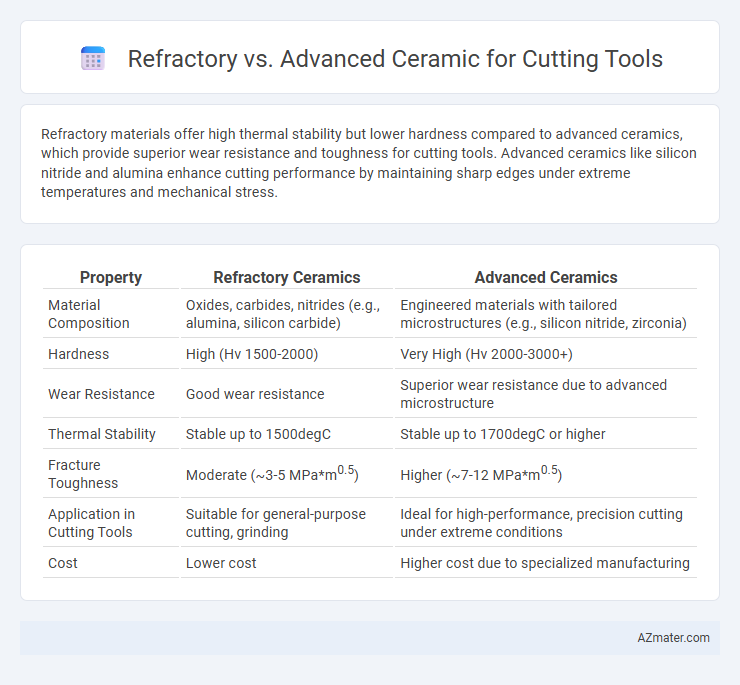Refractory materials offer high thermal stability but lower hardness compared to advanced ceramics, which provide superior wear resistance and toughness for cutting tools. Advanced ceramics like silicon nitride and alumina enhance cutting performance by maintaining sharp edges under extreme temperatures and mechanical stress.
Table of Comparison
| Property | Refractory Ceramics | Advanced Ceramics |
|---|---|---|
| Material Composition | Oxides, carbides, nitrides (e.g., alumina, silicon carbide) | Engineered materials with tailored microstructures (e.g., silicon nitride, zirconia) |
| Hardness | High (Hv 1500-2000) | Very High (Hv 2000-3000+) |
| Wear Resistance | Good wear resistance | Superior wear resistance due to advanced microstructure |
| Thermal Stability | Stable up to 1500degC | Stable up to 1700degC or higher |
| Fracture Toughness | Moderate (~3-5 MPa*m0.5) | Higher (~7-12 MPa*m0.5) |
| Application in Cutting Tools | Suitable for general-purpose cutting, grinding | Ideal for high-performance, precision cutting under extreme conditions |
| Cost | Lower cost | Higher cost due to specialized manufacturing |
Introduction to Cutting Tool Materials
Cutting tool materials are critical in machining processes, where refractory metals and advanced ceramics offer distinct performance advantages. Refractory metals like tungsten carbide provide excellent toughness and wear resistance, making them suitable for heavy-duty cutting applications. Advanced ceramics, such as silicon nitride and aluminum oxide, excel in high-temperature stability and hardness, enabling faster cutting speeds and longer tool life in precision machining.
What Are Refractory Ceramics?
Refractory ceramics are materials capable of withstanding extremely high temperatures and harsh chemical environments, making them ideal for cutting tool applications that involve intense heat and mechanical stress. These ceramics, commonly composed of oxides, carbides, and nitrides like alumina, zirconia, silicon carbide, and titanium nitride, offer superior thermal stability and wear resistance compared to conventional ceramics. Advanced ceramics, while also heat-resistant, typically feature enhanced mechanical properties and microstructural engineering, which provide greater toughness and tool life in precision cutting and machining operations.
Understanding Advanced Ceramics
Advanced ceramics exhibit superior hardness, wear resistance, and thermal stability compared to conventional refractory ceramics, making them ideal for cutting tool applications. These materials, often engineered with fine grains and enhanced microstructures, enable precision machining and longer tool life under high-stress conditions. Understanding advanced ceramics involves recognizing their tailored compositions, such as silicon nitride or alumina, which contribute to improved toughness and fracture resistance in cutting operations.
Key Material Properties Comparison
Refractory metals like tungsten and molybdenum offer exceptional hardness and high melting points ideal for cutting tool durability under extreme temperatures. Advanced ceramics, including silicon nitride and alumina, provide superior wear resistance and thermal stability with lower density, enhancing tool longevity and performance. Comparing thermal conductivity and fracture toughness highlights refractory metals' resilience against thermal shock, while advanced ceramics excel in maintaining sharp cutting edges due to their hardness and chemical inertness.
Performance in High-Speed Machining
Refractory materials exhibit excellent thermal stability and wear resistance, making them suitable for cutting tools in high-speed machining where temperatures can exceed 1000degC. Advanced ceramics, such as silicon nitride or alumina composites, provide superior hardness and toughness, enabling greater precision and extended tool life under high-speed conditions. Performance in high-speed machining favors advanced ceramics due to their ability to maintain cutting edge integrity while reducing friction and thermal deformation compared to traditional refractory materials.
Wear Resistance: Refractory vs Advanced Ceramics
Refractory ceramics exhibit high thermal stability and mechanical strength, making them suitable for cutting tools subjected to intense heat and stress; however, advanced ceramics such as silicon nitride and alumina provide superior wear resistance due to their enhanced hardness and fracture toughness. The improved wear resistance of advanced ceramics results in longer tool life and better performance in precision machining of hard materials. In comparison, refractory ceramics may degrade faster under abrasive conditions, limiting their effectiveness in high-wear environments.
Thermal Stability Under Cutting Conditions
Refractory ceramics exhibit exceptional thermal stability under cutting conditions, maintaining hardness and resistance to thermal shock at temperatures exceeding 1700degC. Advanced ceramics, such as silicon nitride and silicon carbide, provide superior toughness and wear resistance while sustaining stable mechanical properties up to around 1400degC. This thermal reliability ensures cutting tools made from refractory ceramics perform efficiently in high-temperature machining, whereas advanced ceramics balance thermal stability with fracture toughness for improved tool life.
Cost-Effectiveness and Availability
Refractory ceramics, such as aluminum oxide and silicon carbide, offer cost-effectiveness due to lower raw material expenses and widespread availability, making them suitable for standard cutting tool applications. Advanced ceramics like cubic boron nitride (CBN) and silicon nitride provide superior hardness and thermal resistance but come with higher production costs and limited availability, impacting overall cost-efficiency. Choosing between these ceramics depends on balancing initial investment against performance needs and tool lifespan in specific machining environments.
Applications in the Cutting Tool Industry
Refractory ceramics, such as alumina and silicon carbide, are widely used in cutting tools for high-temperature machining and wear resistance, particularly in metal cutting and grinding applications. Advanced ceramics like cubic boron nitride (CBN) and silicon nitride offer superior hardness, thermal stability, and toughness, making them ideal for precision cutting and high-speed machining of hardened steels and superalloys. The cutting tool industry relies on the combination of refractory ceramics for cost-effective, general-purpose tools and advanced ceramics for high-performance, specialized applications requiring extended tool life and enhanced cutting efficiency.
Choosing the Right Ceramic for Cutting Tools
Refractory ceramics, known for high thermal resistance and toughness, excel in cutting tools designed for heavy-duty machining and high-temperature applications. Advanced ceramics, such as silicon nitride and alumina composites, offer superior hardness and wear resistance, making them ideal for precision cutting and high-speed operations. Selecting the right ceramic hinges on the specific machining conditions, balancing toughness, thermal stability, and wear resistance to maximize tool life and performance.

Infographic: Refractory vs Advanced ceramic for Cutting tool
 azmater.com
azmater.com